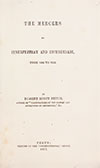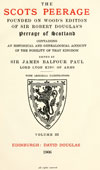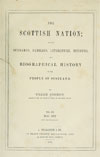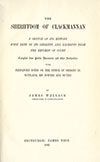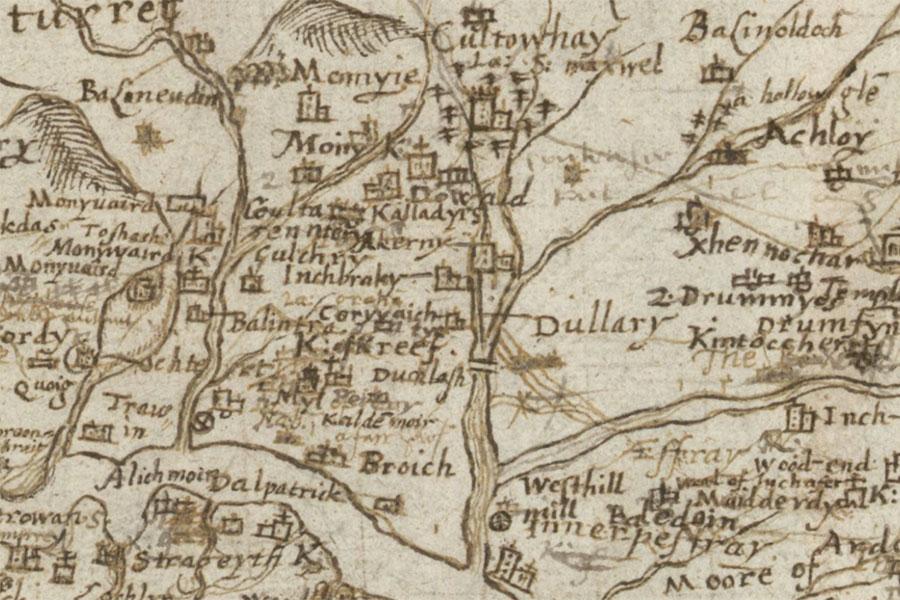

Dollerie was a tower house belonging to the Murray family, but it was superseded by the nearby Dollerie House in the 18th century.
Who built the first castle at Dollerie, or Easter Dollerie, is not known. The property seems to have been part of the lands of Innerpeffray which were owned by the Earls of Strathearn from as early as the late 13th century. The earliest recorded owner of the lands of Dollerie specifically seems to be Malcolm de Innerpeffray, who received a charter from Robert Bruce at Rosneath in 1318 or 1319 confirming a donation to him from Malise III, Earl of Strathearn, of the lands of Dollerie and Meikleour.
The lands of Innerpeffray, including the properties of Dollerie and Inchbraikie, seem to have passed to the Mercer family through marriage. It has been suggested that the marriage was between a Robert Mercer and the daughter of a Patrick or Peter de Innerpeffray and his wife Margaret de Fassington in the second half of the 14th century.
Robert’s eldest son, also Robert, inherited his father’s estates, while his second son, Andrew, married Margaret Murray of Tullibardine around 1438 and took a mortgage of the lands of Inchbraikie around 1440.
In 1454 Robert Mercer of Innerpeffray, the grandson of the first Robert, is described as owning the “lordship of Dollerie” and the same year gave the Abbey of Inchaffray rights to eel fishing at “Polpefery” (Pow of Inchaffray) within the lordship.
Robert seems to have got into financial difficulties and in 1465 sold his lands to Thomas Oliphant of Dron, the Lundie family, the Colquhouns of Luss and the Murrays of Tullibardine. Patrick Murray, son of David Murray of Ochtertyre, one of the Murrays of Tullibardine, had a charter of Easter and Wester Dollerie in 1467.
The estate of Dollerie was part of the muir of Madderty which was granted to Anthony Murray by the Abbey of Inchaffray in 1554. I have been unable to ascertain how Dollerie came into the possession of the Abbey, however a George Murray was the Abbot of Inchaffray in the mid-15th century until his resignation in 1495 so there may have been a family connection. When Murray resigned as abbot Laurence Oliphant, 4th Lord Oliphant, Aberdalgie and Dupplin, became commendator of the abbey.
In 1662 Patrick Murray, the 7th laird of Dollerie, gave Wester Dollerie to his second son James, minister of Logierait, while Easter Dollerie subsequently became the property of the Murrays of Abercairny.
Dollerie is marked on Pont’s late 16th century map of Lower Glen Almond and Strathearn as “Dullary”, and on John Adair’s 1720 map (based on his 1683 manuscript) as “Dolore”.

John Adair, 1720
Around 1780 a new house, known as Dollerie House, was built around 100m to the south of the tower house. The old house was demolished to basement level, with the vaulted basement converted for use as an icehouse.
The original tower house may have been occupied up until at least the mid-18th century as a stone tablet dated 1741 was reportedly taken from it and installed in the west wall of the new house. It is carved with the initials AM, for Anthony Murray, a Murray star, and the following inscription:
in humane life thers nothing stedfast stands youth riches glorie fades deaths sure att hand
However some sources give an early 18th century date for the central part of Dollerie House so it may be that the stone tablet is in its original position and the tower house was vacated earlier than thought.
Dollerie House was altered and extended in 1867 and consists of a long two storey building within which is embedded a tall, narrow stair tower topped off with an ogee roof. It is now a private home set within a 116 acre estate and was still owned by the Murray family until they put it up for sale in 2013, selling in 2015.
Alternative names for Dollerie
Dallorea; Dollarie; Dollary; Dollerie House; Dolore; Dowlary; Dullary; Easter Dollerie






